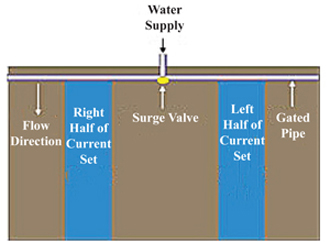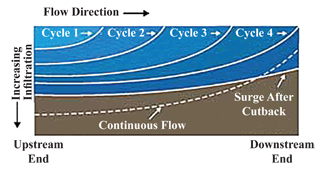G1870
Fundamentals of Surge Irrigation
This NebGuide provides the fundamental background for surge irrigation and how surge can improve water management.
C. Dean Yonts, Extension Irrigation Engineer
Dean E. Eisenhauer, Professor, Biological Systems Engineering
|
Furrow irrigation is used on approximately 2.0 million acres in Nebraska. Some farmers are switching from furrow to center pivot irrigation to reduce labor and improve irrigation performance. Surge irrigation may provide furrow irrigators with similar advantages without investing in major equipment.
Surge irrigation or surge flow intermittently applies water to an irrigation furrow. Continuous flow for the entire irrigation set time is the normal process of applying water. Surge irrigation was first studied as a method of reducing the amount of runoff that occurred during irrigation. It was discovered that water moved to the end of the field more quickly when applied intermittently than when applied continuously.
Water can be applied intermittently by cycling irrigation water between two sides of a surge valve. Prior to the development of the surge valve, water was cycled when it was not getting to the end of a field. The irrigator would move on to subsequent sets and return in one or two days to finish irrigating the partially watered sets. The second time, the irrigation water could be moved all the way to the end of the field because the soil surface had sealed and more water was available at the point where flow had stopped. This same process is used with modern surge irrigation, except the cycling is done automatically for short durations of 20 minutes to two hours. A typical surge irrigation system is shown in Figure 1.
How Surge Irrigation Works
When water first contacts the soil in an irrigation furrow, the infiltration rate is high. As the water continues to run, the infiltration rate at that point in the furrow is reduced to a near-constant rate. If water is shut off and allowed to infiltrate, the surface soil particles consolidate and form a partial seal in the furrow. When water is reintroduced to the furrow, the intake rate can be reduced due to this partial sealing action. The result is more water movement down the furrow and less infiltration into the soil.
High infiltration rates can lead to poor irrigation system performance due to deep percolation and poor water distribution across the field. Surge flow can increase irrigation performance by providing a more uniform application. In Figure 2, the infiltration pattern of surge and continuous flows show the potential difference in uniformity of water application between the two systems.
Rather than turning the water on and off to achieve intermittent flow, an irrigation surge valve is used to alternate flow between open gates on either side of the surge valve. Cycle times used with surge irrigation vary with soil texture, slope and field length. Fine-textured soils respond less to surge irrigation than do coarse-textured soils that have higher initial intake rates. If field slope is so steep that it causes a rapid rate of advance, the effects of surge irrigation will be reduced. If a soil’s intake rate is low due to soil texture, tight soils or compacted layers, surge irrigation is likely to be ineffective in reducing the irrigation advance times below those for continuous flow.
Surge flow has been used in some cases to reduce irrigation runoff by using short duration cycles after the water has reached the end of a field. This helps maintain high uniformity of water application and improve the overall irrigation performance. Another advantage to surge irrigation, unrelated to the improvements in irrigation system performance, is that the surge valve can be used to improve irrigation system management without a large increase in labor requirements. The surge controller provides a two-set automated furrow irrigation system.
Limitations
There are two potential drawbacks associated with surge flow. First, surge flow may not always reduce the advance time of water down the furrow. If it does not, there may still be benefits of labor savings and runoff reduction. Because infiltration rates are often lower with surge flow, a second concern is with net water application. If infiltration rates are reduced with surge flow, less water may be stored in the root zone during an irrigation set. If this occurs, the irrigator must compensate by irrigating more frequently or increasing the set time to avoid under watering. Proper irrigation scheduling may become even more important when surge irrigation is used.
Proper field leveling is also important when surge irrigation is used. Many irrigators that have low spots or reverse grades have observed water ponding and infiltrating in these low areas to the extent that advance times are actually increased. This has been observed more often on coarse textured soils than on fine textured soils. Some touch-up grading to eliminate back slopes may be necessary in these situations.
Required Equipment
Normally, a surge valve with an automated controller will cost between $1,500 and $2,500 depending on the size of the valve and the controller options. Using a surge valve often requires that somewhere in the system, pipe is used to convey water to the desired location of the valve. Lay-flat or disposable plastic tubing may be a low cost alternative. Remember that getting over the field during the first irrigation in half or three quarters of the time it normally takes may more than pay for a valve in a single year. The inability to automate and the inherent inefficiency of furrow irrigation causes some furrow irrigators to apply more than twice the amount of water that a crop can use. By realizing a water savings, enough fuel and labor could be saved to expect the surge system to pay for itself in just a few years.
Summary
Surge irrigation provides farmers that use furrow irrigation an opportunity to irrigate more effectively. By reducing infiltration rates, surge irrigation allows smaller applications which can improve irrigation performance. In addition, reducing deep percolation may reduce the potential for chemical leaching to the groundwater. Surge irrigation can help reduce runoff losses and can assist in labor management. The effects of surge irrigation are most prevalent during the first irrigation when the soil intake rate is high. Although intake rates decrease as the season progresses, the advantages of surge continue in the ability to manage water supplies by keeping water on the field and minimizing the amount of runoff leaving the field.
The application of surge irrigation will require a change in management strategy. Surge irrigation often allows the irrigator to apply water more uniformly as well as more effectively. As a result of improved irrigation performance with surge flow, soil water monitoring will be more important in assuring that adequate water is applied and that excessive irrigation is reduced.
For the first few years, additional time may be required to fine-tune the surge system to your particular operation. Once this is accomplished, surge irrigation can help achieve more uniformly irrigated crops, water conservation, reduced pumping costs and improved water quality by reducing deep percolation. Surge irrigation is not for everyone but past success suggests that furrow irrigators should consider it.
Acknowledgment
The authors wish to acknowledge Joel Cahoon and Kelly Wertz for their contributions to the original version of this NebGuide.
This publication has been peer reviewed.
Visit the University of Nebraska–Lincoln Extension Publications Web site for more publications.
Index: Irrigation Engineering
Irrigation Operations and Managment
Issued July 2008

